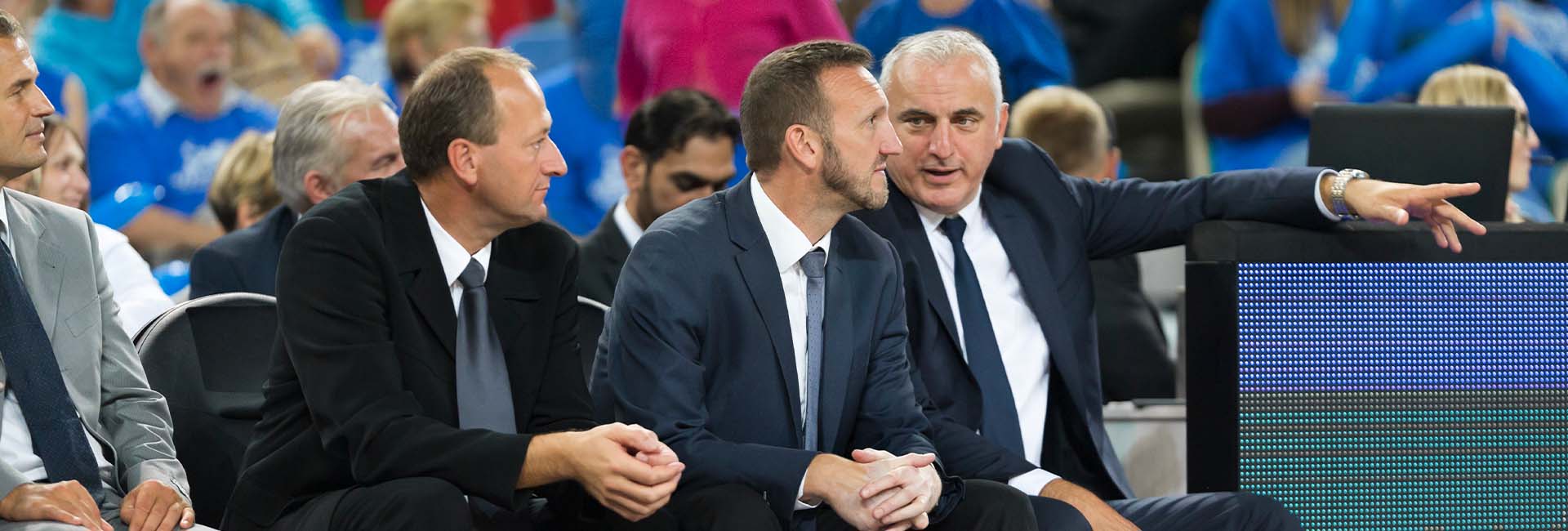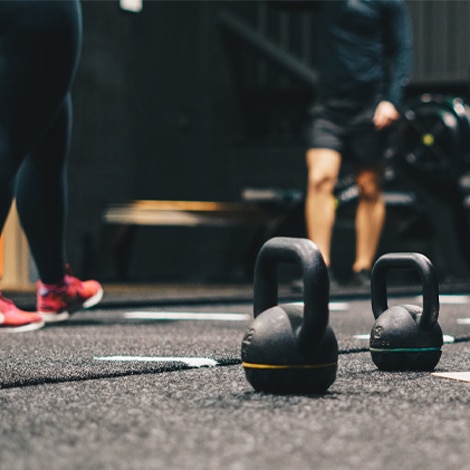by Alex Campanella
At most universities, the human performance staff must provide programming and care for hundreds of athletes across several different men’s and women’s sports teams. This is particularly taxing when there is a small staff on which strength and conditioning coaches bear most of the burden. In this article, we’ll explore how an athlete management system (AMS) can help performance professionals put their attention on those who need it most and efficiently deliver personalized care at scale.
At small colleges, performance staff rarely play just one role, and a single head strength and conditioning coach might be responsible for preparing male and female competitors across all sports. At a mid-major university, there could be three or four coaches responsible for 400, 500, or 600 student-athletes. Even for members of the Power Five conferences that have a larger performance staff, resources are still overstretched, and coach-to-athlete ratios can be at or even above 1 to 100. Coaches might have more assistants to rely on and access to specialists in sports psychology, nutrition, and other disciplines, but 12-hour days and a lengthy list of responsibilities are still the norm.
Such demands not only limit the impact of individual performance practitioners but also stifle communication, hamper the application of sports science, and make it harder to test, train, and treat student-athletes well. Let’s look at how an AMS can help busy performance professionals amplify their effectiveness in collegiate sports.
GETTING MORE FROM PERFORMANCE TESTING
There are some elements of S+C coaching and other performance roles that will never change or go away, such as writing and delivering programs, communicating with sports coaches and the athletic department, and instructing and interacting with student-athletes. But an AMS can help expedite certain tasks, extract greater wisdom from athlete data, and unite disparate systems and roles.
Even if a school lacks the resources to deploy a far-reaching approach from the get-go, applying such a system to basic data sets and a few device integrations can start to give coaches time back so they can be on the floor with athletes more, replace redundant or burdensome minutiae with high-value activities, and become proactive rather than reactive.
Let’s look at load management testing as an example, and suppose a school is using GPS, force plates, and a velocity-based training (VBT) tool. On the front end, using an AMS isn’t going to change much, as the coach will still have to put the GPS pucks in players’ jerseys, get them to jump on the plates, and attach the VBT system to the barbells. But on the back end, a system such as Smartabase can save time, provide greater insight, and increase effectiveness. Before, you’d have to pull up the vendor’s proprietary system and parse through GPS, force, and velocity data manually to try and find some useful information captured by each device individually.
With an AMS in place, data from all three systems is automatically combined and visualized, allowing you to easily see that a certain player’s overall load spiked in the last week. You can then take corrective action – like reducing their volume and intensity – to temporarily lower their load exposure so they don’t run the risk of overtraining or under-recovering.
This is one simple instance in which the AMS saves time, unites disparate systems, and enables you to make more effective decisions that positively impact student-athlete performance.
ENHANCING PLAYER WELLNESS MONITORING
An AMS can also help coaches collect subjective student-athlete data more efficiently via wellness surveys.
Today, this is often done by hand on paper charts affixed to clipboards that get passed around the weight room. Each athlete indicates how sore they are, their rate of perceived exertion (RPE) for each practice and weightlifting session, how well they slept, what their enthusiasm level is, their mental state, and so on. The S+C coach must then go back to their office and enter the information in a spreadsheet or rudimentary database, which provides limited or no reporting capabilities, doesn’t visualize the data, and keeps athlete information stuck in one place, where it isn’t available to other members of the performance staff to act upon as needed.
In contrast, an app like the Smartabase Kiosk allows athletes to self-report their wellness without requiring the coach’s involvement. This information is then sent into the athlete’s record in Smartabase and can be easily reviewed by the coaching staff via a visual dashboard. Thresholds can be determined so if an individual inputs low scores consistently, the system will raise a red flag and notify the relevant personnel – such as the S+C coach, sports psychologist, counselor, and head coach – and they can follow up with the student-athlete.
In this way, performance staff get time returned to them, have a greater insight into the athlete’s wellness and readiness, and can proactively access the expert resources he or she needs to solve issues collaboratively. By offering a 360-degree view of each student-athlete, an AMS better equips a college’s performance staff to meet the emotional and mental health needs of the athletes so nobody slips through the cracks.
IMPROVING COMMUNICATION AND CARE DELIVERY FOR INJURED STUDENT-ATHLETES
An AMS also enables college performance staff to improve communication between various disciplines. Athlete injury is one example.
With a paper-based process, there can be a disconnect in the immediate response to a player getting hurt and a lack of information sharing at various stages in the return-to-play continuum. Whereas with a system such as Smartabase in place, doctors, athletic trainers (ATCs), strength and conditioning coaches, and other specialties are better informed and all on the same page so they can quarterback care more effectively at each stage of the process. Once an ATC logs an injury in the AMS, all relevant personnel are immediately notified so that next steps can be taken in a timely manner.
One of the key advantages this kind of platform provides as the athlete rehabs their injury is that information can be presented to various roles in different ways. A team physician or ATC might get full reports, while sport coaches who don’t have the same background in sports medicine are presented with simpler overviews about the individual’s progress, prognosis, and availability status. The latter is the type of high-level overview that can be delivered quickly and succinctly during a weekly coaches’ meeting for every player who is out injured, while individual updates are sent to the coaching staff and other professionals working with the injured players anytime there is a meaningful change.
This doesn’t just apply to major injuries that require lengthy rehabilitation, such as ACL and Achilles tears, but can also be applied to chronic conditions such as knee tendonitis or elbow bursitis that can impact student-athletes’ availability for competition and practice. Previously, a note might have been taken from the training room to the S+C staff or to the head coach to let them know that a player either wouldn’t be able to train on a given day or should be limited to certain activities so as not to worsen their condition.
With an AMS, such messaging becomes paperless, and notifications can be set up to consistently alert members of the performance staff who might have otherwise missed the information. In this way, they are better able to individualize programming for players who are hurt or have restrictions in place as part of their rehab protocols and aren’t caught unawares when an athlete’s status changes.
ENHANCING MULTI-SPORT PREPARATION
Another way an AMS like Smartabase makes S+C coaches and other performance staff more effective in a university setting is when they have to manage the preparation of athletes across several sports.
For example, let’s say a strength coach oversees volleyball, soccer, and golf. In this instance, there’s no place for one-size-fits-all programming or application of insights gleaned from wearable data, as the game demands of all three sports are so different. With an AMS in place, it’s simple to integrate program design and delivery details from an S+C system like TeamBuildr, TrainHeroic, or BridgeAthletic that allows the coach to monitor the progress of their volleyball and soccer players and golfers as they progress through the different stages of their seasons.
The coach can also overlay this information with real-time and historical data from GPS units and other wearables so they can get a clearer picture of overall load and other key performance indicators (KPIs) that inform changes in training when necessary. Reports can be easily customized to reflect the terminology that coaches in all three sports are familiar with so athlete information is delivered in a tailored, informative, and actionable way.
It can also be communicated to the athletes themselves so they’re more in tune with their own progress. Certain information can be shared with players in a simple way to reinforce facets of performance the coaching staff want to emphasize and to improve education about the importance of hydration, nutrition, sleep, and so on.








